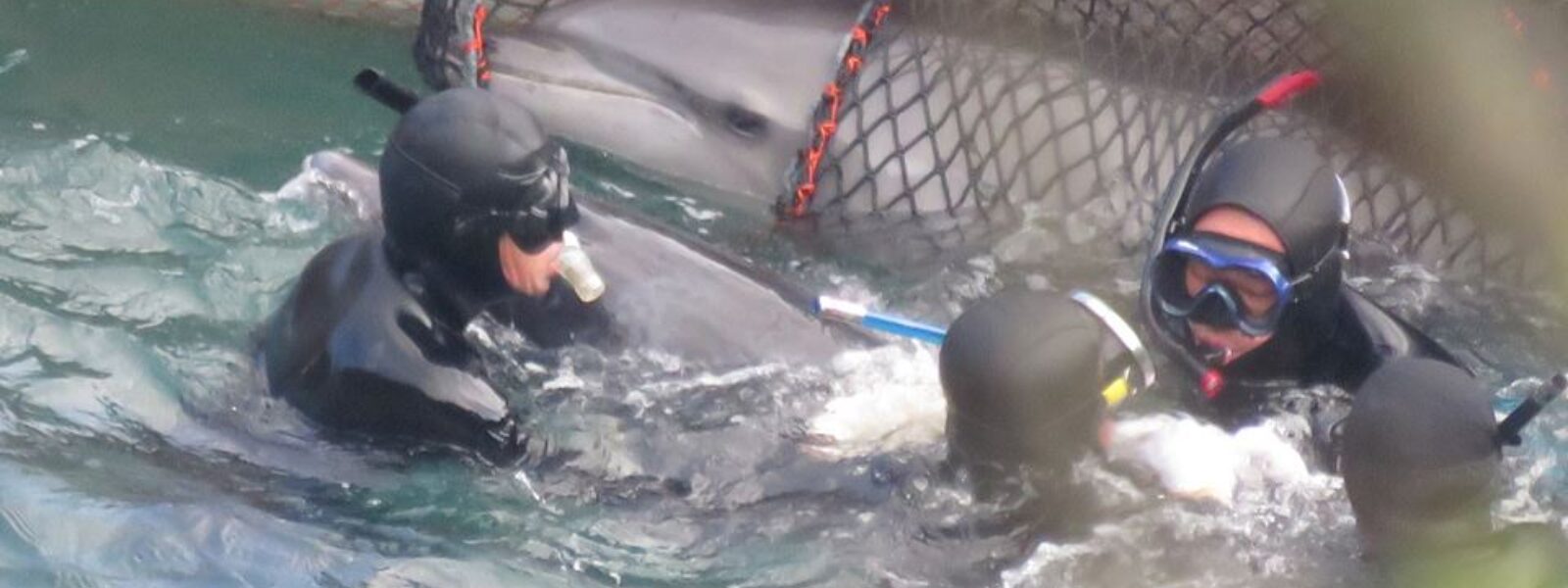

This past weekend, a huge pod of bottlenose dolphins were herded into and held for days in the notorious Cove of Taiji. Estimates by observers from Sea Shepherd Cove Guardians are that 250 or more wild dolphins were herded in, and after five brutal days of divers grabbing and handling virtually the entire pod, at least 100 were put in slings and moved to the small net pens in Taiji harbor for a life of permanent captivity. At least four dolphins died in the process.
Representatives of the captivity industry selected prime “show quality” dolphins for captivity. These are usually young, unblemished female bottlenose dolphins (like the ones used in the popular 1960’s Flipper television show), which are more docile and easily trained than male bottlenose dolphins. Likely, some males were also caught for breeding purposes.
The remaining animals – about 150 – were herded back out to sea. Given that these dolphins were held for five days in the Cove without any food (or drink – dolphins obtain water from eating fish, as they cannot process seawater) and in shock, and now having broken family bonds from dolphins taken into captivity, the long-term survival of these dolphins is doubtful at best. Already, in the nets, at least four dolphins were seen floating belly-up, dead. Experts indicate that many of the ones pushed out to sea may not survive.
Over the previous four and a half months of the current season at Taiji, at least 94 dolphins had been taken into captivity in the Cove hunts, of which 89 are bottlenose dolphins. Now the dolphin hunters of Taiji have added 100 more captives.
Sea Shepherd has documented a few dolphin deaths in the holding pens in Taiji harbor this year, but the total number of captive dolphins now being held is still almost twice as high as the number of bottlenose caught last season (104 captured during 2015-16 season) for captivity.
As we have often pointed out, the captivity trade with aquariums in Japan and other countries is the major financial backer of the dolphin slaughter in Taiji. A dolphin killed for meat will bring around $400 to $600 USD in markets in Taiji and other towns in Japan (depending on the size and species of the dolphin). A trained captive dolphin, on the other hand, will bring as much as $155,000 USD or more on the world captivity market.
Sea Shepherd notes that this potentially means the Taiji hunters could get $15 million USD from the weekend’s catch of captive dolphins. However, prices vary as to how much individual aquariums will pay for the captive dolphins, so the likely take will be less that that, but still likely several million dollars for five days worth of work.
Dolphins from Taiji are used in Japan aquariums and swim-with facilities. There are at least 100 of these dolphin captive facilities around Japan, ranging from small sea pens in harbors to major aquarium parks similar to SeaWorld in the US. About a third of these facilities are members of the Japan Association of Zoos and Aquariums (JAZA), which has required its member aquariums to stop sourcing dolphins from Taiji.
The JAZA ban on Taiji dolphins was the result of a ten-year campaign by Earth Island’s International Marine Mammal Project (IMMP) and other organizations around the world. However, that leaves many other facilities in Japan still willing to buy Taiji dolphins, and, as dolphins do not live long in captivity, Taiji is assured of a major domestic market for captives.
Other places around the world have bought Taiji dolphins, especially aquariums in China, Russia and the Middle East. Taiji is now the major source for captive dolphins in the world, along with Russia (orcas, belugas and some dolphins) and Cuba (bottlenose dolphins).
IMMP has been able to stop dolphin trafficking in the Solomon Islands and helped stop a major proposal from Chinese interests to capture dolphins in Namibia in Africa.
As long as the captivity industry continues to support and pay for the capture and slaughter of hundreds of dolphins each year and as long as the Japan government stands in favor of the slaughter, the Taiji hunts will sadly continue.
Photo and video by Liz Carter.